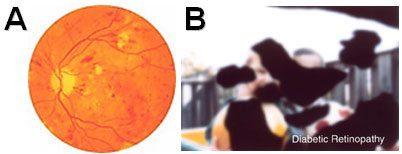
A) Figure showing the back of the eye (retinal fundus) in a patient with diabetic retinopathy. Hemorrhages (bleeding) and fluid leakage (exudates) are shown and indicative of advanced complications due to diabetes. (Figures from www.eyemdlink.com). B) A visual scene as might be viewed by a patient with diabetic retinopathy. (figure from www.nei.nih.gov)
Diabetic retinopathy occurs as a result of uncontrolled blood sugar associated with advanced diabetes and if left untreated, can cause blindness. In diabetic retinopathy, retinal blood vessels are adversely affected and begin to leak. In the early stages of diabetic retinopathy ("nonproliferative retinopathy"), these blood vessels leak fluid and distort sight. In the more advanced stages of diabetic retinopathy ("proliferative retinopathy"), fragile new blood vessels grow within the retina. Treatment involves the use of a laser to destroy leaky blood vessels and to prevent the growth of abnormal new ones. Anyone with diabetes (both Type 1 and Type 2) is at risk of developing diabetic retinopathy. The type of diabetes a person has, how well their blood sugar is controlled, and how long a person has had diabetes all affect the risk and severity.
